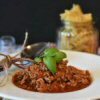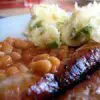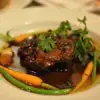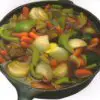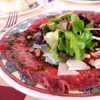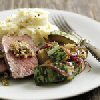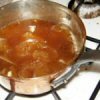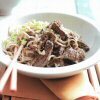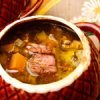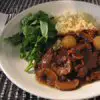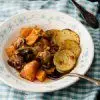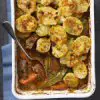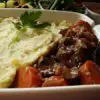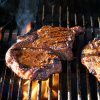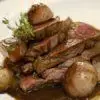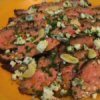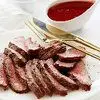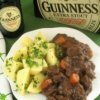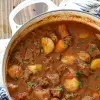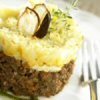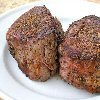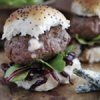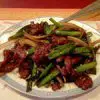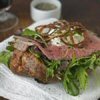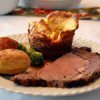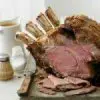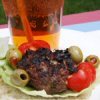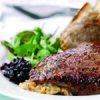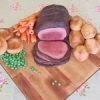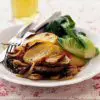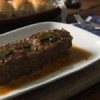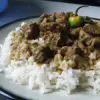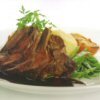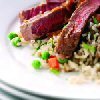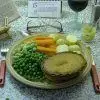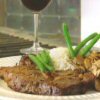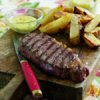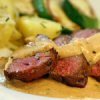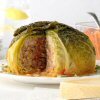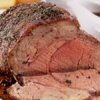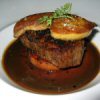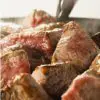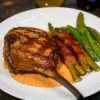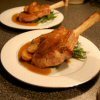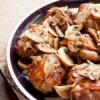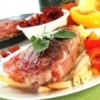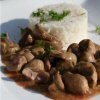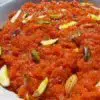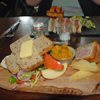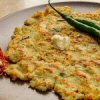BEEF & VEAL RECIPES

Beef is the most important meat to the Western World, representing somewhere in the region of 55% of the total meat expenditure. So important is it to the Brits that the French even refer to them as "Les Roastbeefs", and Americans produce more beef per capita than any other country on earth.
One thing you will need to know, whether buying pre-packed beef or fresh from your butcher, will be how to distinguish the quality and category and also how to prepare and cook beef. Details of this are given below the recipes and you can see the full range of cooking times at Beef Cooking Times.
QUALITY
It is the breed, the age, the sex and the way in which the cattle have been fed that determines the flavour and tenderness of the meat. You will find that there are four different qualities...
Top Quality: intense red, firm texture with a combination of lean and fat meat that gives it a marbled appearance.
Good Quality: intense red, firm texture, white or yellowish fat.
Average Quality: intense red, little fat, little, if any, marbling.
Poor Quality: pink or nearly black meat, coarse texture.
CATEGORY
There are two distinct Categories...
Pieces for quick cooking: where each piece is named and has a well-defined quality. Since these cuts are the prime meat, they are always more expensive than the slower-cooking pieces. Some examples of quick-cooking meats are:
Chateaubriand. A cut 1½" - 2" (3-5cm) thick from the middle of the fillet (taken from the back of the animal). It is necessary to cook a Chateaubriand a little more slowly than other steaks to ensure that the middle is hot without the surface drying or hardening.
Tournedos (or medallion). A slice of fillet about 1" (2.5cm) thick, dressed interspersed with bacon and tied with string.
Entrecote. A thick piece, including bone, cut from the shoulder of the animal. Generally an entrecôte should never weigh less than 2lb (1kg) except when eaten as a steak.
Fillet. Not surprisingly this is a joint taken from the fillet (back) of the animal. It's a particularly tender cut of meat.
Rump. A piece of meat firm the rear end of the animal. Often cut into slices about 1" (2.5cm) thick to be cooked as rump steaks.
Silverside. A piece taken from the rear of the thigh. A nice tender cut but less so than the previous five.
Skirt. (Also known as Romanian tenderloin). The term skirt steak refers to a long, flat cut that is prized for its flavour rather than tenderness. The inside skirt steak is a boneless portion of the flank trimmed free of fat and membranes
Pieces for slow cooking: used in stews for braising. These are usually cut into small pieces and are more bony, sinewy, tendonous and fat than the meats for quick cooking. For example...
Chuck. Taken from the shoulder area of the animal. Suitable for stews and hot pots.The following diagram shows the approximate locations of various cuts of beef, but your butcher will be happy to advise you if you need more detail.
Collar. As the name suggests, this is cut from the animal's neck.
Brisket. A piece from the animal's chest.

Preparing and Cooking Beef
Generally, there is little to do by way of preparation with "quick-cooking" meats since most butchers and food stores will provide it ready-prepared. For "slow-cooking" meats you may have to trim off some surplus fat and gristle. Usually, it is a case of following whatever recipe you are using.
For "quick-cooking" meats (particularly steaks) there are seven categories of cooking but beware because the interpretation varies quite a lot from country to country.
Raw: The meat is simply not cooked at all, for example Steak Tartare or CarpaccioYou may find, in a restaurant that your meat is brought to the table a little less cooked than you demanded. This is because it is always easy to cook the meat a little more if required, but it's impossible to "uncook" it! It's a lesson well worth learning when you begin to cook beef.
Blue: The outside of the meat is quickly sealed, dark red at the surface and nearly raw inside. All juices are retained.
Rare: A little more cooked than 'blue' so that the outside begins to turn golden brown. Deep red in the middle with some blood still apparent.
Medium Rare: Just a fraction more cooked than 'rare' so that the drops of blood inside are absorbed by the cooking. Still very juicy.
Medium: The outside is golden brown and the inside deep red.
Medium-well: A little-prized specimen with the outside a salmony-brown brown colour and the inside pinky-brown and very clear.
Well-done: Ordered only by those who do not appreciate either the taste or texture of meat at its best! Dark brown on the outside and a paler but consistent brown on the inside. Often becomes rather dry and chewy.
The main methods of cooking are:
Roasting: (Suitable for large cuts of meat.) The joint is placed in a roasting tin in a hot oven for a few minutes to seal the juices. The oven is then turned down and the meat allowed to cook more slowly. The recognised cooking times are available here.
Braising: (Suitable for "slow-cooking" cuts.) Braising is to cook gently in a greased or buttered pan, with the lid on, either in the oven or on the hob. Because it is a slow process, it will 'tenderise' even the poorest cuts.
Pan-Frying: (Suitable for smaller steaks.) I'm not suggesting that you should 'fry' steak in the traditional sense of the word (as you might a sausage for example) although some cuts, like skirt, come out very well from this method, but many excellent recipes use the 'pan-fried' method of cooking (for example Steak with Mustard Cream Sauce)
Grilling: (Again, suitable for smaller steaks.) Grilling is the simplest, quickest and most efficient method of cooking a steak. Unfortunately, one tends to lose all the juices so any sauces have to be made without the benefit of the flavour of the meat.
Stew and Hot-Pots: (Suitable for poorer quality meats or minced meat.) Since stews are an inexpensive way to feed a hungry family, we all come to rely on them from time-to-time, so you will find that I have included recipes for beef cooked in this fashion.
What To Eat Tonight
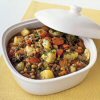
28 Freezer-Friendly Recipes
Not everything is right for freezing. Some foods, however, just beg to go into the freezer waiting for that moment when you need them most!

57 Ways with Bacon
Oh, bacon, bacon, bacon. What can we say? Seen by many as a true gift from the gods, bacon is just so tasty, so versatile and so more-ish.
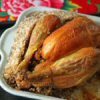
44 Poultry & Game Birds
Whether it's a chicken or a partridge, a turkey or a pheasant, we have a recipe that will help you get the very best from your food.


